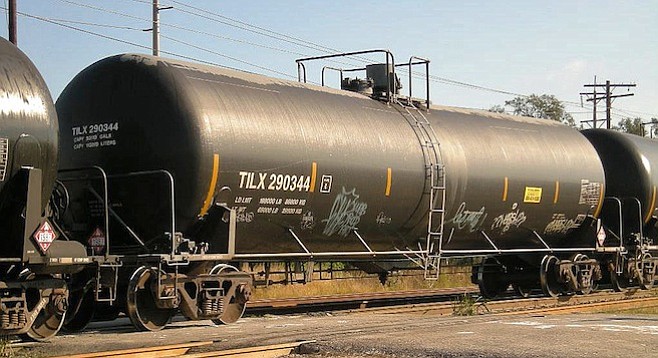 Facebook
Facebook
 X
X
 Instagram
Instagram
 TikTok
TikTok
 Youtube
Youtube

While federal investigators continue to probe the troubled operations of the San Diego Metropolitan Transit System's so-called Desert Line railroad through Mexico to the Imperial Valley, a more immediate concern involving the safety of cross-border rail traffic has come to light.
According to a March 3 audit by the Inspector General's office of the Homeland Security department, railroads carrying cargo to the U.S. from Canada and Mexico have been inadequately inspected for radiation and other terror threats.
U.S. Customs and Border Patrol "did not effectively target and examine rail shipments entering the United States from Mexico and Canada," the document says.
As a result, the audit says, customs agents "may have failed to require examinations of rail shipments that were at a higher risk to contain contraband, dangerous goods, or weapons of mass destruction." In addition, federal agents "may also have failed to detect potential instruments of terrorism or dangerous materials from entering the United States."
San Diego's railroad link to Mexico, running on tracks owned by San Diego's Metropolitan Transit System, crosses the border at Tijuana and serves as a key trade tie, each night hauling tank cars filled with volatile propane south and returning north through downtown with empties, along with Mexican-originated freight.
According to a Metropolitan Transit System fact sheet, the line from downtown to Mexico is 15.5 miles long. "This Line extends through Mexico (44.3 miles) and connects up with the Desert Line. The portion through Mexico, originally constructed as part of the Main Line, is now owned by the Mexican national railways, Ferrocarril Sonora Baja California Line."
The federal auditors reviewed security deficiencies at six unidentified U.S. ports of entry.
They discovered that customs agents "did not always target shipments using the mandatory Automated Targeting System targeting criteria," and "did not always use the required radiation detection equipment to examine high-risk shipments."
Customs was supposed to deploy so-called non-intrusive detection equipment at each port of entry. The machines use “gamma rays to produce images of railcars for detection of contraband such as drugs, undeclared merchandise, and weapons. The gamma ray source and detectors are stationary as the train moves through the system. There is a designated personnel exclusion zone for personnel safety."
But auditors found that agents "were unaware of the correct targeting criteria or inadvertently used inappropriate criteria," and "one port did not have the required radiation detection equipment for its rail team." In addition, according to the document, agents at two other ports wrongly employed "Personal Radiation Detectors to examine shipments."
Thus, the auditors found, there is "no assurance that decisions to release these high-risk shipments into U.S. commerce were appropriate." Customs officials agreed with the audit's findings and vowed to correct the problems, the document says.


While federal investigators continue to probe the troubled operations of the San Diego Metropolitan Transit System's so-called Desert Line railroad through Mexico to the Imperial Valley, a more immediate concern involving the safety of cross-border rail traffic has come to light.
According to a March 3 audit by the Inspector General's office of the Homeland Security department, railroads carrying cargo to the U.S. from Canada and Mexico have been inadequately inspected for radiation and other terror threats.
U.S. Customs and Border Patrol "did not effectively target and examine rail shipments entering the United States from Mexico and Canada," the document says.
As a result, the audit says, customs agents "may have failed to require examinations of rail shipments that were at a higher risk to contain contraband, dangerous goods, or weapons of mass destruction." In addition, federal agents "may also have failed to detect potential instruments of terrorism or dangerous materials from entering the United States."
San Diego's railroad link to Mexico, running on tracks owned by San Diego's Metropolitan Transit System, crosses the border at Tijuana and serves as a key trade tie, each night hauling tank cars filled with volatile propane south and returning north through downtown with empties, along with Mexican-originated freight.
According to a Metropolitan Transit System fact sheet, the line from downtown to Mexico is 15.5 miles long. "This Line extends through Mexico (44.3 miles) and connects up with the Desert Line. The portion through Mexico, originally constructed as part of the Main Line, is now owned by the Mexican national railways, Ferrocarril Sonora Baja California Line."
The federal auditors reviewed security deficiencies at six unidentified U.S. ports of entry.
They discovered that customs agents "did not always target shipments using the mandatory Automated Targeting System targeting criteria," and "did not always use the required radiation detection equipment to examine high-risk shipments."
Customs was supposed to deploy so-called non-intrusive detection equipment at each port of entry. The machines use “gamma rays to produce images of railcars for detection of contraband such as drugs, undeclared merchandise, and weapons. The gamma ray source and detectors are stationary as the train moves through the system. There is a designated personnel exclusion zone for personnel safety."
But auditors found that agents "were unaware of the correct targeting criteria or inadvertently used inappropriate criteria," and "one port did not have the required radiation detection equipment for its rail team." In addition, according to the document, agents at two other ports wrongly employed "Personal Radiation Detectors to examine shipments."
Thus, the auditors found, there is "no assurance that decisions to release these high-risk shipments into U.S. commerce were appropriate." Customs officials agreed with the audit's findings and vowed to correct the problems, the document says.
Comments